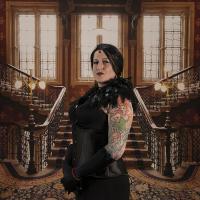“Please, could you please arrange greater opportunities for us to improve our photography by holding more practical evenings?” is a plea often heard from members of the Society. It was extremely gratifying, therefore, to witness such a supportive turnout last Wednesday. The hard-working Committee had responded positively by staging an evening on indoor photography at the St John Ambulance HQ, using different types of artificial lighting. It was very obvious on entering our meeting room that they had gone to a great deal of trouble re-arranging everything in advance and erecting tripods and suitably artistic backdrops!
Long before members had arrived, our current President, Tony Curtis, ably assisted by Nigel Owen and Jeremy Broome-Smith, had been busy setting up the meeting room with blackout blinds and all of the necessary equipment for two different set-ups. These, in summary, were constant LED lighting and traditional studio lighting. There was, in addition, off-camera flash gun lighting, utilising a transmitter on the camera’s hot shoe.
The less experienced members were then offered helpful and patient guidance and tuition on how best to use the three different set-ups and gently encouraged to use their own cameras to test the results for themselves which each of them produced. They had been asked to bring their own cameras along with them as this was to be a part of the learning process.
In addition, to make the evening even more interesting, three models had been invited to come along to be photographed. These were Hazel Walsh, Jason Bickle and Matthew Buttery who were dressed in Halloween-type attire which made for dramatic portraiture subjects.
Those present had varying degrees of experience but they were all able to take various learning points away with them at the end of a successful, relaxed, fun evening. First, they learned that there is no need to fear ‘having a go’ and experimenting with artificial lighting. Second, as with buying cameras, it is not necessary to spend a fortune on acquiring the basic lighting equipment. Thirdly, there really is no need to feel mystified by the more technical aspects if the standard rules are observed. Setting up then becomes essentially a matter of trial and error to see what best suits the outcome the photographer is seeking to achieve, making sometimes minor adjustments to the positioning of the lights until the balance gives a satisfactory outcome. Finally, there are always more experienced members in the Society who are willing to answer questions and share tips and suggestions on this photographic topic (or any other within the realms of this fascinating hobby).
We next meet on 3rd November at 7.00 pm at the St John Ambulance HQ, off Glencrutchery Road. Members – all guests will be welcomed and asked to pay a modest admission charge) - are promised a most interesting evening with local historian and photographer, Charles Guard.
The IOMPS gratefully acknowledges the continued support of the Arts Council.
By Antony Hamilton



